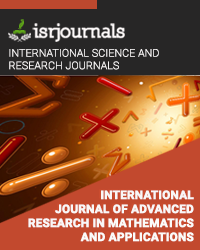solving fuzzy transportation problem using symmetric triangular fuzzy number
S. Nareshkumar,S. Kumara Ghuru
Published in International Journal of Advanced Research in Mathematics and Applications
ISSN: 2350-028X Impact Factor:1.2 Volume:1 Issue:1 Year: 17 July,2014 Pages:74-83

Abstract
The transportation problem is one of the earliest applications of linear programming problems. In the literature, several methods are proposed for solving transportation problems in fuzzy environment but in all the proposed methods, the parameters are normal fuzzy numbers. In this paper, a general fuzzy transportation problem is discussed. In the proposed method, transportation cost, availability and demand of the product are represented by symmetric triangular fuzzy numbers. We develop fuzzy version of Vogel’s algorithms for finding fuzzy optimal solution of fuzzy transportation problem. A numerical example is given to show the efficiency of the method.
Kewords
Fuzzy sets, Symmetric Triangular Fuzzy numbers, Fuzzy transportation problem, Fuzzy ranking, Fuzzy arithmetic
Reference
[1]. Arsham H and A. B. Kahn, A simplex type algorithm for general transportation problems: An alternative to stepping-stone, Journal of Operational Research Society, 40 (1989), 581-590. [2]. Bellman R. E. and L. A. Zadeh, Decision making in a fuzzy environment, Management science, 17(1970), 141-164. [3]. Chanas S, D. Kuchta, A concept of optimal solution of the transportation with Fuzzy cost co efficient, Fuzzy sets and systems, 82(9) (1996), 299-305. [4]. Chanas S, W. Kolodziejczyk and A. Machaj, A fuzzy approach to the transportation problem, Fuzzy Sets and Systems, 13(1984), 211-221. [5]. Dubois D. and H. Prade, Fuzzy Sets and Systems, Theory and applications, Academic Press, New York,1980. [6]. Edward Samuel and A. Nagoor Gani, Simplex type algorithm for solving fuzzy transportation problem, Tamsui oxford journal of information and mathematical sciences, 27(1) (2011), 89-98. [7]. Nagoor Gani, K. A. Razak, Two stage fuzzy transportation problem, Journal of Physical Sciences, 10 (2006), 63–69. [8]. Gass, On solving the transportation problem, Journal of operational research Society, 41 (1990), 291-297. [9]. Lious.T.S. and Wang.M.J, Ranking fuzzy numbers with integral value, Fuzzy sets and systems, 50 (3) (1992), 247-255. [10]. S. T. Liu, C. Kao, Solving Fuzzy transportation problem based on extension principle, European Journal of Operations Research, 153 (2004), 661-674. [11]. Pandian. P and Nagarajan. G, A new algorithm for finding a fuzzy optimal solution for fuzzy transportation problem, Applied Mathematics Sciences, 4 (2) (2010),79-90 [12]. Shiang-Tai Liu and Chiang Kao, Solving fuzzy transportation problems based on extension principle, Journal of Physical Science, 10 (2006), 63-69. [13]. Shiv Kant Kumar, Indu Bhusan Lal and Varma. S. P, An alternative method for obtaining initial feasible solution to a transportation problem and test for optimality, International journal for computer sciences and communications, 2(2) (2011),455-457. [14]. Tanaka, H. Ichihashi and K. Asai, A formulation of fuzzy linear programming based on comparison of fuzzy numbers, Control and Cybernetics, 13 (1984), 185-194. [15]. Zadeh L. A., Fuzzy sets, Information Control, 8 (1965), 338-353. [16]. Zimmermann H. J., Fuzzy Set Theory and Its Applications, Kluwer Academic, Norwell.MA, 1991. [17]. Zimmermann H. J., Fuzzy programming and linear programming with several objective functions, fuzzy sets and systems, 1 (1978), 45-55. [18]. Zitarelli D. E. and R. F. Coughlin, Finite Mathematics with applications, New York: Saunders College Publishing 1989.

